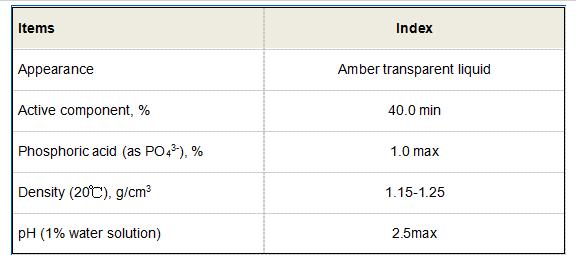Synthesis and Applications of Diethylene Triamine Penta Methylene Phosphonic Acid in Industrial Chemistry
The Role of Diethylene Triamine Penta Methylene Phosphonic Acid in Water Treatment
Diethylene Triamine Penta Methylene Phosphonic Acid (DTPMPA) is a highly effective chelating agent widely used in water treatment and various industrial applications. This multifunctional phosphonic acid is recognized for its ability to sequester metal ions, making it invaluable in managing scale formation, corrosion, and sedimentation in water systems. This article explores the properties, applications, and benefits of DTPMPA in water treatment processes.
Chemical Properties
DTPMPA is a synthetic compound characterized by having multiple phosphonic acid functional groups and amine groups. Its molecular structure allows it to form stable complexes with metal ions, particularly calcium, magnesium, and iron. This chelation process is pivotal in water treatment, where hard water can lead to calcification and scaling in industrial systems. By binding to these metal ions, DTPMPA effectively reduces their availability to form deposits, thus minimizing the risk of scaling.
Applications in Water Treatment
The primary application of DTPMPA in water treatment is in the prevention of scale formation and corrosion in cooling towers, boilers, and other industrial water systems. When water is heated or evaporated, concentrated mineral content can lead to the precipitation of scale, causing operational inefficiencies and potential equipment damage. DTPMPA acts as a scale inhibitor by maintaining metal ions in solution and preventing their crystallization.
diethylene triamine penta methylene phosphonic acid

Moreover, DTPMPA is often used in formulations for detergents, household cleaners, and industrial cleaning agents. Its ability to bind metal ions helps improve the efficacy of these products by preventing the interference of hard water ions that can impede cleaning performance.
Environmental and Economic Benefits
One of the most compelling advantages of using DTPMPA is its relatively low environmental impact compared to traditional phosphates. Phosphates have been widely criticized for contributing to eutrophication in water bodies, leading to the excessive growth of algae and detrimental effects on aquatic ecosystems. In contrast, DTPMPA offers a phosphate-free alternative, promoting sustainability in water treatment processes.
Economically, the use of DTPMPA can result in significant cost savings for industries through reduced maintenance expenses. By preventing scale and corrosion, companies can avoid costly repairs and outages, leading to more efficient and reliable operations. Furthermore, the enhanced performance in cleaning and treatment processes can decrease the volume of chemicals needed, further reducing operational costs.
Conclusion
Diethylene Triamine Penta Methylene Phosphonic Acid (DTPMPA) stands out as a versatile and effective agent in water treatment applications. Its chelating properties make it an essential tool for managing scale and corrosion, thereby improving the efficiency of various industrial processes. With a reduced environmental impact and the potential for significant cost savings, DTPMPA represents a forward-thinking approach to modern water treatment challenges. As industries continue to prioritize sustainability and efficiency, the role of compounds like DTPMPA will likely become increasingly significant in achieving these goals.
-
Understanding Polycarboxylic Acids: Properties, Applications, and Future PotentialNewsJul.28,2025
-
Scale Inhibitor Explained: How to Protect Your System from Limescale and Hard Water DamageNewsJul.28,2025
-
Scale and Corrosion Inhibitors: Essential Chemicals for Industrial Water System ProtectionNewsJul.28,2025
-
Polyaspartic Acid: A Biodegradable Polymer for Sustainable ChemistryNewsJul.28,2025
-
Isothiazolinones: A Versatile Antimicrobial Class with Industrial Power and Regulatory ChallengesNewsJul.28,2025
-
A Deep Dive into 2-Phosphonobutane-1,2,4-Tricarboxylic Acid (PBTC)NewsJul.28,2025





